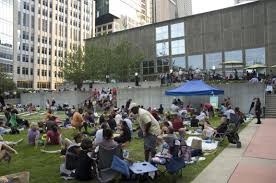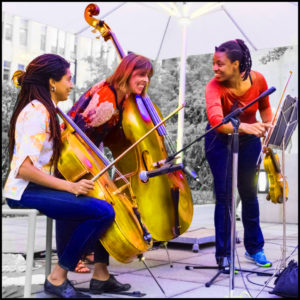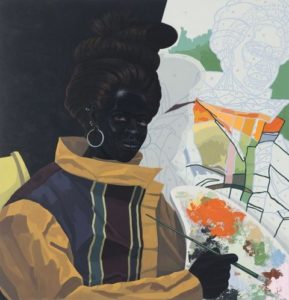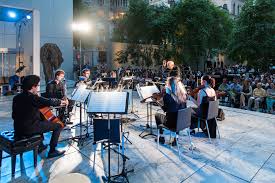Chicago’s Museum of Contemporary Art has aced outdoor music presentations with its Tuesdays on the Terrace series, most recently featuring the string trio Hear In Now performing strong yet sensitive chamber jazz. Drawing a thoroughly diversified crowd to enjoy fresh, creative music in open space on a summer afternoon for free (food and beverages extra) shouldn’t be difficult, but it’s the kind of programming New York’s Museum of Modern Art tried off and on for decades, seldom conquering the format’s challenges.
Cellist Tomeka Reid, violinist Mazz Swift and bassist Sylvia Bolognesi held rapt an audience sitting in folding chairs directly in front of their tented stage, another block of seating on the far side of a stairways in use throughout the two sets, 5:30 to 8 pm, and people at tables on a level above the musicians. Another coterie of attendees was spread across grass on the street level of the MCA’s “backyard” — sound was decently amplified into that space, but no one seemed constrained from socializing, and their conversations did not bleed up into the main music area.
People were also invited to enter the Museum itself, especially to view the powerful retrospective of Kerry James Marshall’s paintings — explosive, subversive and celebratory visions of black America. All together, the outdoors music and indoors exhibitions provided a welcoming ambiance for visitors old, young and in-between, black and white and other.
Marshall’s visions could easily be taken as counterparts of Hear in Now’s music. The painter and the players are all masterful (the retrospective is titled “Mastry”) and multi-layered. Ms.s Reid, Swift and Bolognesi plucked and bowed transparent but dense and busily detailed narratives — that is, pieces that seemed to go somewhere, purposefully. Each of the women plays precisely, virtuosically and with guts. They took chances, seeming to revel in surprising each other, never smug and indeed nearly giddy with pleasure in their collaboration. All three contributed framework compositions upon which to expand, Swift sometimes singing along with her fiery arco work. A version of one of H.T. (Harry) Burleigh’s spiritual-inspired songs was singularly affecting. Their concentration and satisfaction transmitted directly to their listeners — players and witnesses seemed united in one experience, always the goal of performances.
However, the achievement of that goal by institutions offering serious music out-of-doors must not be taken for granted. MOMA started presenting its Summergarden series of concerts in its sculpture garden in the 1960s — a wonderful Milt Jackson-James Moody album was recorded live there in ’65, the same year Sonny Rollins led an all-star band in the garden through There Will Never Be Another You. Rollins returned to record The Solo Album in 1985. In the ’90s I went to Summergarden performances by John Cage, Butch Morris and Henry Threadgill’s ensembles, among others, but
MOMA’s amplification system did not deliver evenly throughout the walled space, traffic commotion on adjacent 54th St. was typically disruptive,there was often a stiffness in the presentation and an abiding sense that MOMA was concerned its free offerings might be too popular, the sculpture garden not big enough to handle all comers and those attendees potentially unruly, too. Perhaps these problems were solved for the four Sunday night Summergarden concerts MOMA produced this year.

MCA rear view, grass and terrace. Stage is usually set up on the upper level, at left – Lawndale News (no copyright infringement intended)
The MCA’s physical situation has some advantages, not least of them being its terrace’s distance above busy Chicago Avenue running along side. Traffic noises still threaten — Hear in Now at one point dealt confidently with an ambulance siren cutting through the air by continuing to press its group sound, enfolding the whine.
I can’t say how this works at the Los Angeles County Museum of Art (LACMA) which has won ASCAP/Chamber Music America awards for its adventurous programming, but one thing is clear: People love the musical and social opportunities these museums provide. Local artists and citizens from anywhere meet at these cool places for happy occasions. Applause for the musicians and the presenting institutions, too.
howardmandel.com
Subscribe by Email |
Subscribe by RSS |
Follow on Twitter
All JBJ posts |



